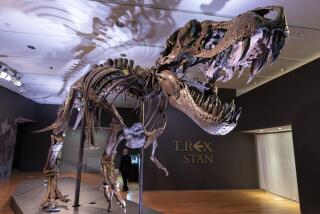Tyrannosaur bone found in Australia
Tyrannosaurs may have stalked far more of the globe than previously thought.
Scientists for the first time have found evidence of an ancestor of Tyrannosaurus rex in the Southern Hemisphere, a discovery that could shed light on tyrannosaursâ evolutionary lineage, which many scientists had thought was restricted to the Northern Hemisphere after the continents began to separate.
Tyrannosaurs had been documented only in Asia, Europe and North America, but a hip bone discovered in Australia could have come only from a tyrannosaur, researchers have concluded. They described their finding in a paper published online Thursday in the journal Science.
The discovery raises questions about how and why the two-legged carnivores evolved to become dominant predators above the equator, and why they may have failed to do so below it.
âWe think tyrannosaurs became global early in history,â said lead author Roger Benson, a paleontologist at the University of Cambridge, âbut for some reason, in the north tyrannosaurs became exceptionally successful predators, and in south, they just dwindled away.â
Benson, along with colleagues at the Natural History Museum in London and Museum Victoria in Melbourne, Australia, concluded that tyrannosaurs lived Down Under after analyzing a distinctive bone discovered at Dinosaur Cove in Victoria state.
The bone had been uncovered, along with hundreds of other fossils from a variety of species, by Museum Victoria paleontologist Thomas Rich in 1989. Last year, Rich took them to Benson and other colleagues in Europe to see whether they could identify any of the fossils. Among them was the hip bone.
This new dinosaur was much smaller than T. rex, probably about 175 pounds and 10 feet long as opposed to T. rexâs 8,000 pounds and 39 feet. The hip bone itself measures about a foot, compared with 53 inches for that of a T. rex.
The new tyrannosaur, known as NMV P186069, has not yet been fully described. It appears to share some basic characteristics with the similarly primitive northern ancestors of T. rex that lived 110 million years ago, about 40 million years before T. rex first stalked Earth.
Calling the earlier tyrannosaurs âthe jackals of the early part of the age of dinosaurs,â tyrannosaur expert Thomas R. Holtz Jr. said the more primitive species focused on small to mid-size prey. Once larger predators died off in the Northern Hemisphere, the tyrannosaur lineage was free to evolve into larger predators, the University of Maryland paleontologist said.
Why a similar evolution didnât occur in the Southern Hemisphere, and why tyrannosaurs have not previously been seen below the equator, is a mystery, he said.
âThese are mostly the unwritten chapters of dinosaur history,â Holtz said.
âWe really donât have much of a clue as to what Australian dinosaurs were like at the time.â
More to Read
Sign up for Essential California
The most important California stories and recommendations in your inbox every morning.
You may occasionally receive promotional content from the Los Angeles Times.









